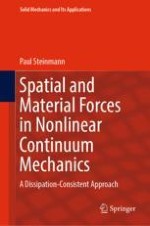2022 | OriginalPaper | Chapter
12. Consequences of Thermodynamical Balances
Author : Paul Steinmann
Published in: Spatial and Material Forces in Nonlinear Continuum Mechanics
Publisher: Springer International Publishing
Activate our intelligent search to find suitable subject content or patents.
Select sections of text to find matching patents with Artificial Intelligence. powered by
Select sections of text to find additional relevant content using AI-assisted search. powered by
